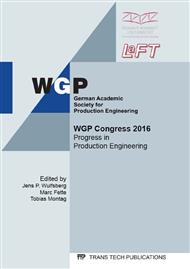[1]
H.J. Warnecke,H. -J. Bullinger, Virtual Reality '94 - Anwendung und Trends, Springer-Verlag, Berlin, (1994).
Google Scholar
[2]
J. Brade, M. Lorenz, M. Busch, N. Hammer, M. Tscheligi, P. Klimant, Being There Again – Presence in Real and Virtual Environments and its Relation to Usability and User Experience: in Review.
DOI: 10.1016/j.ijhcs.2017.01.004
Google Scholar
[3]
M.J. Schuemie, P. van der Straaten, M. Krijn, C.A.P.G. van der Mast, Research on Presence in Virtual Reality: A Survey, CyberPsychologie & Behavior 4 (2) (2001) 183-201.
DOI: 10.1089/109493101300117884
Google Scholar
[4]
M. Slater,S. Wilbur, A Framework for Immersive Virtual Environments (FIVE): Speculations on the Role of Presence in Virtual Environments, Presence: Teleoperators and Virtual Environments 6 (6) (1997) 603-616.
DOI: 10.1162/pres.1997.6.6.603
Google Scholar
[5]
E.L. -C. Law, V. Roto, M. Hassenzahl, A.P.O.S. Vermeeren, J. Kort, Understanding, scoping and defining user experience, Proceedings of the SIGCHI Conference on Human Factors in Computing Systems (2009) 719-728.
DOI: 10.1145/1518701.1518813
Google Scholar
[6]
M. Usoh, E. Catena, S. Arman, M. Slater, Using Presence Questionnaires in Reality, Presence: Teleoperators and Virtual Environments 9 (5) (2000) 497-503.
DOI: 10.1162/105474600566989
Google Scholar
[7]
S. Nisenfeld, Using Reality to Evaluate the ITC Presence, 2003, Unpublished Master Thesis.
Google Scholar
[8]
J. Lessister, J. Freeman, E. Keogh, J. Davidoff, A Cross-Media Presence Questionnaire: The ITC-Sense of Presence Inventory, Presence: Teleoperators and Virtual Environments 10 (3) (2001) 282-297.
DOI: 10.1162/105474601300343612
Google Scholar
[9]
M. Busch, M. Lorenz, M. Tscheligi, C. Hochleitner, T. Schulz. Being There For Real – Presence in Real and Virtual Environments and its Relation to Usability, NordiCHI, (2014).
DOI: 10.1145/2639189.2639224
Google Scholar
[10]
S. Sylaiou, K. Mania, A. Karoulis, M. White, Exploring the relationship between presence and enjoyment in a virtual museum, International Journal of Human-Computer Studies 68 (5) (2010) 243-253.
DOI: 10.1016/j.ijhcs.2009.11.002
Google Scholar
[11]
H. Patel,S. Nichols. View of the future: overview of the experimental programme via quantitative meta-analysis, Virtual Reality design and evaluation workshop, (2004).
Google Scholar
[12]
S. Henderson,S. Feiner, Exploring the Benefits of Augmented Reality Documentation for Maintenance and Repair, IEEE Transactions on Visualization and Computer Graphics 17 (10) (2011) 1355-1368.
DOI: 10.1109/tvcg.2010.245
Google Scholar
[13]
C. Cruz-Neira, D.J. Sandin, T.A. DeFanti, R.V. Kenyon, J.C. Hart, The CAVE: audio visual experience automatic virtual environment, Communications of the ACM 36 (6) (1992) 64-72.
DOI: 10.1145/129888.129892
Google Scholar
[14]
Information on https: /de. actionbound. com/, (June 6th 2016).
Google Scholar
[15]
Information on http: /droid-developer. blogspot. de/, (June 6th 2016).
Google Scholar
[16]
M. Lorenz, M. Busch, L. Rentzos, M. Tscheligi, P. Klimant, P. Fröhlich. I'm There! The Influence of Virtual Reality and Mixed Reality Environments Combined with Two Different Navigation Methods on Presence, IEEE Virtual Reality, (2015).
DOI: 10.1109/vr.2015.7223376
Google Scholar
[17]
B. Laugwitz, T. Held, M. Schrepp, Construction and Evaluation of a User Experience Questionnaire, HCI and Usability for Education and Work, Springer-Verlag Berlin Heidelberg Graz, 2008, pp.63-76.
DOI: 10.1007/978-3-540-89350-9_6
Google Scholar
[18]
M. Rauschenberger, M. Schrepp, M. Perez-Cota, S. Olschner, J. Thomaschewski, Efficient Measurement of the User Experience of Interactive Products. How to use the User Experience Questionnaire (UEQ). Example: Spanish Language Version, International Journal of Interactive Multimedia and Artificial Intelligence 2 (1) (2013).
DOI: 10.9781/ijimai.2013.215
Google Scholar
[19]
J. Brooke, SUS - A quick and dirty usability scale, Usability Evaluation in Industry, Taylor & Francis Inc. Bristol, 1996, pp.189-194.
DOI: 10.1201/9781498710411-35
Google Scholar
[20]
S.E. Kober. Effects of Age on the Subjective Presence Experience in Virtual Reality, Proceedings of the International Society for Presence Research, (2014).
Google Scholar
[21]
A. Bangor, P. Kortum, J. Miller, Determining What Individual SUS Scores Mean: Adding an Adjective Rating Scale, Journal of Usability Studies (2009) 114-123.
Google Scholar
[22]
U. Herrmann, Lernen findet im Gehirn statt. Die Herausforderungen der Pädagogik durch die Gehirnforschung, in R. Caspary, Lernen und Gehirn: Der Weg zu einer neuen Pädagogik, Herder Spektrum Freiburg/Basel/Wien, 2006, pp.85-98.
Google Scholar


